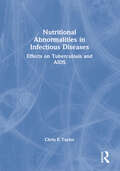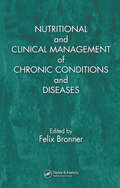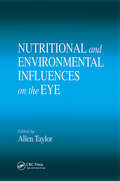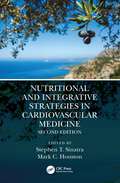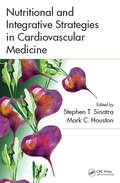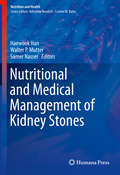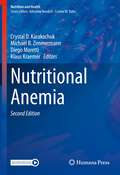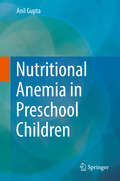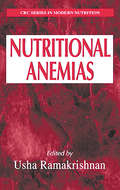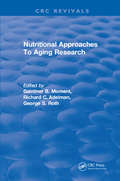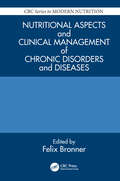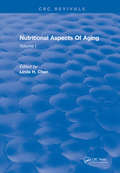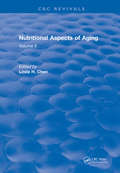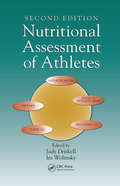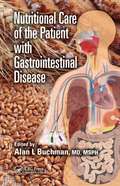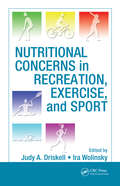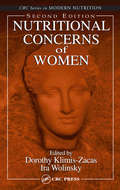- Table View
- List View
Nutritional Abnormalities in Infectious Diseases: Effects on Tuberculosis and AIDS
by Chris E TaylorListed in the 1997 edition of Doody’s Rating Service: A Buyer’s Guide to the 250 Best Health Sciences Books!Until recently, it had been presumed that chemotherapy was sufficient to control tuberculosis (TB). However, it has been estimated that this disease will claim more than 30 million lives in the coming decade. The emergence of multidrug resistant strains, the lack of patient adherence to therapy, and the resultant growing number of TB cases has made it clear that alternative approaches to fight this disease must be taken. Nutritional Abnormalities in Infectious Diseases: Effects on Tuberculosis and AIDS focuses on nutritional factors in relation to tuberculosis and AIDS to help you better understand and treat these diseases. Health care providers and researchers can refer to this valuable resource to identify the most crucial nutritional determinants involved in the control of TB, outline the nutrient-sensitive host defense mechanisms involved, define the effects of malabsorption and drug-drug interactions, and demonstrate the effects of co-infection with HIV on the incidence of TB.Representing the findings of a symposium held during the 94th General Meeting of the American Society for Microbiology, in Las Vegas, Nevada, Nutritional Abnormalities in Infectious Diseases is the work of several outstanding scientists who were invited to make presentations on selected aspects of nutrition and infectious diseases. They give you valuable information about: the effects of malnutrition on host immune parameters intracellular host defense mechanisms phagocytosis the role of cytokines the immune function vitamin A, zinc, and protein deficiency malnutrition and the developing worldWhile the role of adequate nutrition in maintaining a healthy individual is certainly well-known, the findings in Nutritional Abnormalities in Infectious Diseases uncover the role of nutrition in the progression of tuberculosis and AIDS--a matter of great economic and public health significance. Intended for researchers, practitioners, and health care providers in colleges, universities, and government institutions, this important session was sponsored in part by the Respiratory Disease Branch, Division of Microbiology & Infectious Diseases, NIAID.
Nutritional and Clinical Management of Chronic Conditions and Diseases
by Felix BronnerNutritional status is recognized as a major determinant in health and disease. Effective treatment of chronic conditions such as obesity or of diseases of the skin requires the integration of clinical and nutritional management. Nutritional and Clinical Management of Chronic Conditions and Diseases, like its predecessor, Nutritional Aspects and Cli
Nutritional and Environmental Influences on the Eye (Modern Nutrition Ser.)
by Allen TaylorSignificant advancements in nutrition's impact on the eye have occurred faster than any volume can document... until now. This book gives the background and rationale regarding the physiological damage caused by biological oxidants as well as the rationale for the protective roles for nutrient-antioxidants and how they affect the risk for cataracts. This volume also contains information on how to quantitatively assess age-related diseases of the eye including cataracts and age-related maculopathy. Smoking and light exposure as factors for age-related eye diseases as well as the utility of potential anticataract pharmaceuticals is discussed.
Nutritional and Environmental Influences on the Eye (Modern Nutrition Ser.)
by Allen TaylorSignificant advancements in nutrition's impact on the eye have occurred faster than any volume can document... until now. This book gives the background and rationale regarding the physiological damage caused by biological oxidants as well as the rationale for the protective roles for nutrient-antioxidants and how they affect the risk for cataracts. This volume also contains information on how to quantitatively assess age-related diseases of the eye including cataracts and age-related maculopathy. Smoking and light exposure as factors for age-related eye diseases as well as the utility of potential anticataract pharmaceuticals is discussed.
Nutritional and Integrative Strategies in Cardiovascular Medicine
by Stephen T. SinatraBuilding upon its predecessor, this new edition provides an in-depth review of the role of nutrition on cardiovascular health and disease. It provides scientific and clinical insight from leaders in the field of cardiovascular medicine who explore an integrative approach to treating and curing cardiovascular diseases through conventional and non allopathic methodologies. This evidence-based book describes how to integrate nutrition, supplements, lifestyle changes, and medications for improved outcomes in several diseases and conditions including hypertension, diabetes mellitus, metabolic syndrome, and obesity.
Nutritional and Integrative Strategies in Cardiovascular Medicine
by Stephen T. Sinatra Mark C. HoustonDespite 40 years of aggressive pharmaceutical and surgical interventions, coronary artery disease (CAD) remains the number one killer of women and men in Western civilization. When it comes to CAD, prevention is easier than cure, and if CAD does present itself, a combination of conventional and alternative methodologies can truly make a difference
Nutritional and Integrative Strategies in Cardiovascular Medicine
by Stephen T. Sinatra Mark C. HoustonDespite 40 years of aggressive pharmaceutical and surgical interventions, coronary artery disease (CAD) remains the number one killer of women and men in Western civilization. When it comes to CAD, prevention is easier than cure, and if CAD does present itself, a combination of conventional and alternative methodologies can truly make a difference
Nutritional and Integrative Strategies in Cardiovascular Medicine
by Stephen T. Sinatra Mark C. HoustonBuilding upon its predecessor, this new edition provides an in-depth review of the role of nutrition on cardiovascular health and disease. It provides scientific and clinical insight from leaders in the field of cardiovascular medicine who explore an integrative approach to treating and curing cardiovascular diseases through conventional and non allopathic methodologies. This evidence-based book describes how to integrate nutrition, supplements, lifestyle changes, and medications for improved outcomes in several diseases and conditions including hypertension, diabetes mellitus, metabolic syndrome, and obesity.
Nutritional and Medical Management of Kidney Stones (Nutrition and Health)
by Haewook Han Walter P. Mutter Samer NasserThis text comprehensively covers the nutritional and medical management and prevention of kidney stones. Sections address types of stones, nutritional risks, medical and pharmaceutical managements, prevention of recurrence, and special consideration of stone risks among specific diseases such as obesity with gastric bypass, chronic kidney disease, and gastric intestinal disorders. Diagnosis of kidney stones, urinalysis and biochemical indices, dietary assessment, and medical nutrition therapy for specific types of kidney stones are also included. In addition, case studies are provided in the appendix. Cutting edge research is also highlighted in regards to pharmaceutical treatments and epidemiological findings in nutrition and kidney stones. Nutrition in Medical Management of Kidney Stones will be a practical resource for health professionals in the fields of nutrition, nephrology, urology, and general medicine, as well as medical students, resident physicians, and allied health clinicians whose research, practice, and education includes nutrition and kidney stones.
Nutritional Anemia (Nutrition and Health)
by Klaus Kraemer Crystal D. Karakochuk Michael B. Zimmermann Diego MorettiUnderstanding the causes of anemia is critical to inform appropriate strategies to prevent and treat anemia, particularly to reduce the risk of anemia and the burden of disease. The strength of this book lies in its cross-disciplinary nature. This publication summarizes the current state of evidence on the multifactorial causes of anemia, with a specific focus on nutritional anemia. The chapter authors are leading experts in nutrition and global health. The introductory chapters provide an overview of the global burden of anemia prevalence, the economic implications and functional consequences of anemia, and the significance of these factors to guide policy and programs. Subsequent chapters provide current evidence on iron and other micronutrient metabolism and homeostasis in regards to anemia, the multifactorial contributors to anemia (e.g. infection and genetics), and the interactions between nutrients that may contribute to anemia. The summarizing chapters detail program and policy approaches to treat, prevent and reduce anemia in the global context. Nutritional Anemia is a comprehensive resource for those involved in global health and nutrition policy, strategy, programming, or research, and serves as a guide for how government, NGO, and international agencies can effectively treat, prevent and reduce anemia globally.
Nutritional Anemia in Preschool Children
by Anil GuptaThe book highlights intricate predisposing factors for pathogenesis of nutritional anemia. It delivers valuable information related to this public health hazard influencing the nutritional health of preschool children. The book is valuable for readers in diverse fields to gain insight of the concept of nutritional anemia in preschool children. Additionally, book furnishes clinical and laboratory methods in a comparative way to assess nutritional anemia. Impact of the disorder on health of preschool children has been covered in a simple language. The book mentions need for interventional strategies for the management of nutritional anemia. Infants, preschool children and women during pregnancy and lactation are highly susceptible to dietary deficiency of iron, folic acid and cyanocobalamin leading to comparatively, higher predisposition to development of nutritional anemia. The condition has myriad of ill effects on nutritional health of preschool children.
Nutritional Anemias
by Usha RamakrishnanAnemias resulting from nutritional factors constitute the largest nutrition health problem affecting populations in both developed and developing nations. Nutritional Anemias examines these anemias in detail and offers a balanced approach that includes current research findings on the etiology and consequences of this important problem. Th
Nutritional Approaches To Aging Research
by Gairdner B. Moment Richard C. Adleman George S. RothThe general plan of this volume, Nutritional Approaches to Aging Research is for each chapter to present first a reasonably succinct state-of-the-art appraisal of present knowledge in the particular field or problem covered. This will vary considerable depending on the subject matter. Following this, each chapter will focus on the problems and pitfalls, both conceptual and technological, of work in the particular field and, no less important, present some of the opportunities and implications of work in that particular area.
Nutritional Approaches To Aging Research
by Gairdner B. Moment Richard C. Adleman George S. RothThe general plan of this volume, Nutritional Approaches to Aging Research is for each chapter to present first a reasonably succinct state-of-the-art appraisal of present knowledge in the particular field or problem covered. This will vary considerable depending on the subject matter. Following this, each chapter will focus on the problems and pitfalls, both conceptual and technological, of work in the particular field and, no less important, present some of the opportunities and implications of work in that particular area.
Nutritional Aspects and Clinical Management of Chronic Disorders and Diseases
by Felix BronnerPremature births, musculoskeletal diseases, diabetes mellitus, and psychiatric disorders. Nutrition plays a direct or indirect role in the causes, treatment, and/or management of many chronic disorders and diseases, yet nutritional and dietary intervention is often left solely to paramedical staff. This book shows why nutritional and dietary interv
Nutritional Aspects and Clinical Management of Chronic Disorders and Diseases
by Felix BronnerPremature births, musculoskeletal diseases, diabetes mellitus, and psychiatric disorders. Nutrition plays a direct or indirect role in the causes, treatment, and/or management of many chronic disorders and diseases, yet nutritional and dietary intervention is often left solely to paramedical staff. This book shows why nutritional and dietary interv
Nutritional Aspects Of Aging: Volume 1
by Linda H. ChenThe first section in Volume 1 describes the fundamentals of nutrition and aging which include research strategies for the study of nutrition and aging. The nutritional modulation of the aging process which has provided a major breakthrough in the field of nutrition and longevity is also discussed. These include biomedical influences, and social and psychological aspects. Section 3 includes dietary characteristics of the elderly population and methods for the assessment of nutritional status. The nutritional status of the elderly with respect to individual nutrients as determined by dietary survey and by biochemical methods is described in Section 4. Section 4 also includes discussion on nutrient metabolism, requirements, nutritional imbalances, and deficiencies of nutrients. Energy metabolism and obesity as a factor in pathogenesis of diseases are also discussed.
Nutritional Aspects Of Aging: Volume 2
by Linda H. ChenIn the first section of Volume 2, toxicological factors affecting nutritional status are discussed. Medications and alcohol may affect nutritional status. Section 2 provides a discussion of nutrition-related diseases which occur more frequently among the elderly. Cardiovascular diseases including coronary heart disease and cerebrovascular disease are the leading causes of death in the U.S. The relative importance of cardiovascular diseases, in terms of all deaths for the given age group, rises steadily with age. The death rate from these diseases is 28% for the middle age group (35 to 44) and is 69% for the old age group (age 75 and above. This reflects the continued progression of artherosclerosis with aging. Cancer is the second leading cause of death in the U.S. The death rate from cancer also rises steadily with age. The death rate from diabetes mellitus increases progressively with age and more rapidly after the age of 45. The incidence of diabetes mellitus is 0.23% under age 25 and 6.2% over 45.
Nutritional Aspects Of Aging: Volume 1
by Linda H. ChenThe first section in Volume 1 describes the fundamentals of nutrition and aging which include research strategies for the study of nutrition and aging. The nutritional modulation of the aging process which has provided a major breakthrough in the field of nutrition and longevity is also discussed. These include biomedical influences, and social and psychological aspects. Section 3 includes dietary characteristics of the elderly population and methods for the assessment of nutritional status. The nutritional status of the elderly with respect to individual nutrients as determined by dietary survey and by biochemical methods is described in Section 4. Section 4 also includes discussion on nutrient metabolism, requirements, nutritional imbalances, and deficiencies of nutrients. Energy metabolism and obesity as a factor in pathogenesis of diseases are also discussed.
Nutritional Aspects Of Aging: Volume 2
by Linda H. ChenIn the first section of Volume 2, toxicological factors affecting nutritional status are discussed. Medications and alcohol may affect nutritional status. Section 2 provides a discussion of nutrition-related diseases which occur more frequently among the elderly. Cardiovascular diseases including coronary heart disease and cerebrovascular disease are the leading causes of death in the U.S. The relative importance of cardiovascular diseases, in terms of all deaths for the given age group, rises steadily with age. The death rate from these diseases is 28% for the middle age group (35 to 44) and is 69% for the old age group (age 75 and above. This reflects the continued progression of artherosclerosis with aging. Cancer is the second leading cause of death in the U.S. The death rate from cancer also rises steadily with age. The death rate from diabetes mellitus increases progressively with age and more rapidly after the age of 45. The incidence of diabetes mellitus is 0.23% under age 25 and 6.2% over 45.
Nutritional Assessment of Athletes
by Judy A. Driskell Ira WolinskyNutritional assessment is a key to determining the health and performance efficiency of professional, collegiate, and recreational athletes. Expanded to include new chapters, the second edition of Nutritional Assessment of Athletes examines the dietary, nutritional, and physical needs of athletes and describes critical biochemical and cli
Nutritional Care of the Patient with Gastrointestinal Disease
by Alan L BuchmanNutritional management is an integral part of the management for virtually all gastrointestinal diseases. Nutritional Care of the Patient with Gastrointestinal Disease fills a current void in nutritional education by providing a reference for diagnosing and managing common nutritional issues related to gastrointestinal disease. Its separation into
Nutritional Concerns in Recreation, Exercise, and Sport
by Judy A. Driskell Ira WolinskyAthletes, coaches, and recreationalists are continually seeking ways to maximize their competitive efforts in both exercise and sport, and from 5km runners to Olympians, most athletes recognize that good nutrition is as crucial to success as ongoing practice and regular exercise. Written and edited by top-notch nutrition and exercise authorities, N
Nutritional Concerns of Women
by Dorothy Klimis-Zacas Ira WolinskyWomen's health and nutrition concerns have moved to the forefront of research with the mandate by the National Institutes of Health to include women in formerly male-only studies assessing responses to diet and disease. This second edition of a popular and highly praised resource provides new research results that detail the prevalence of and diffe
Nutritional Concerns of Women
by Dorothy Klimis-Zacas Ira WolinskyWomen's health and nutrition concerns have moved to the forefront of research with the mandate by the National Institutes of Health to include women in formerly male-only studies assessing responses to diet and disease. This second edition of a popular and highly praised resource provides new research results that detail the prevalence of and diffe
